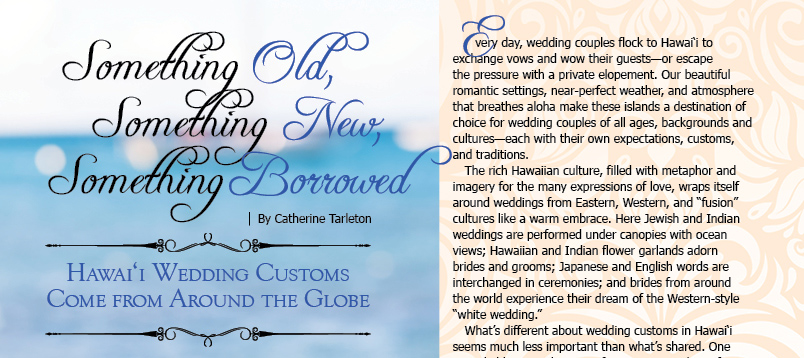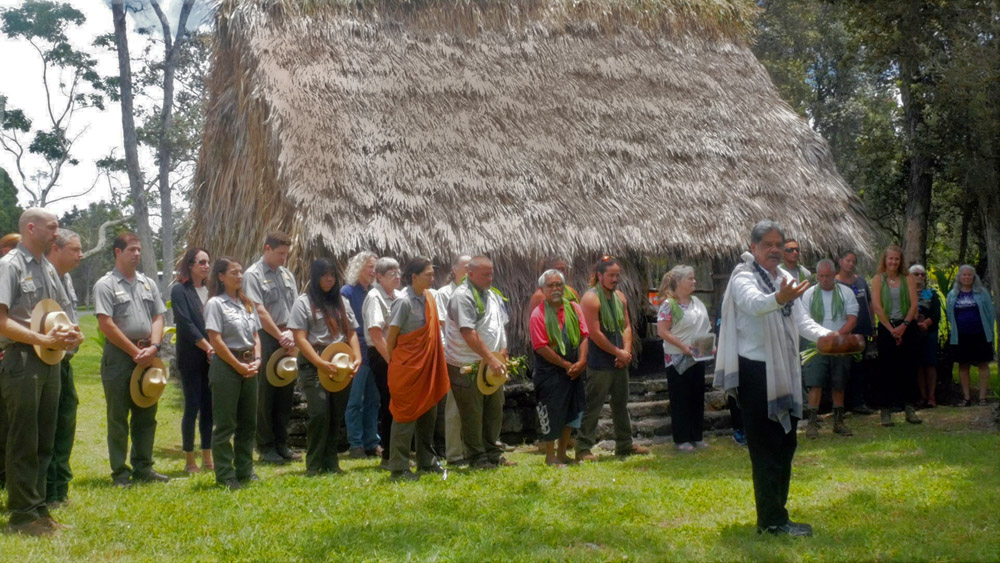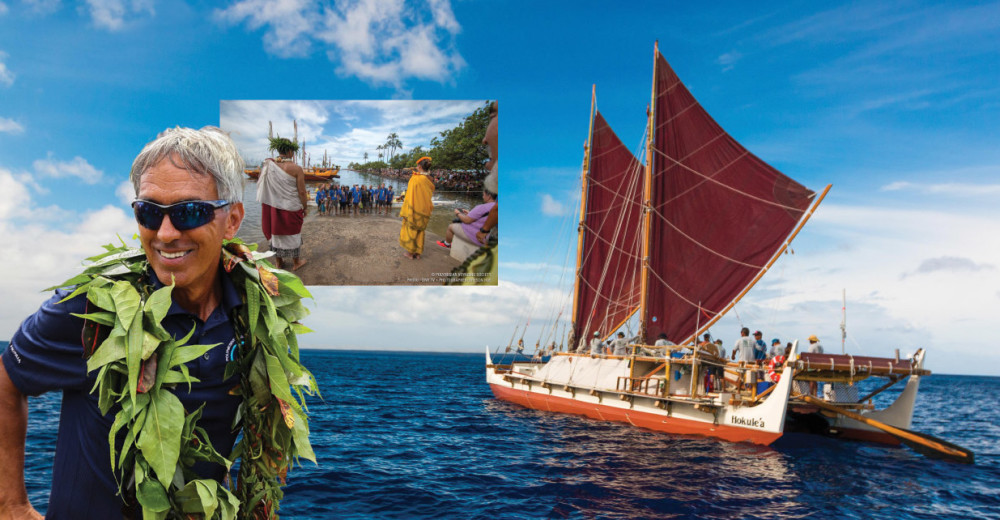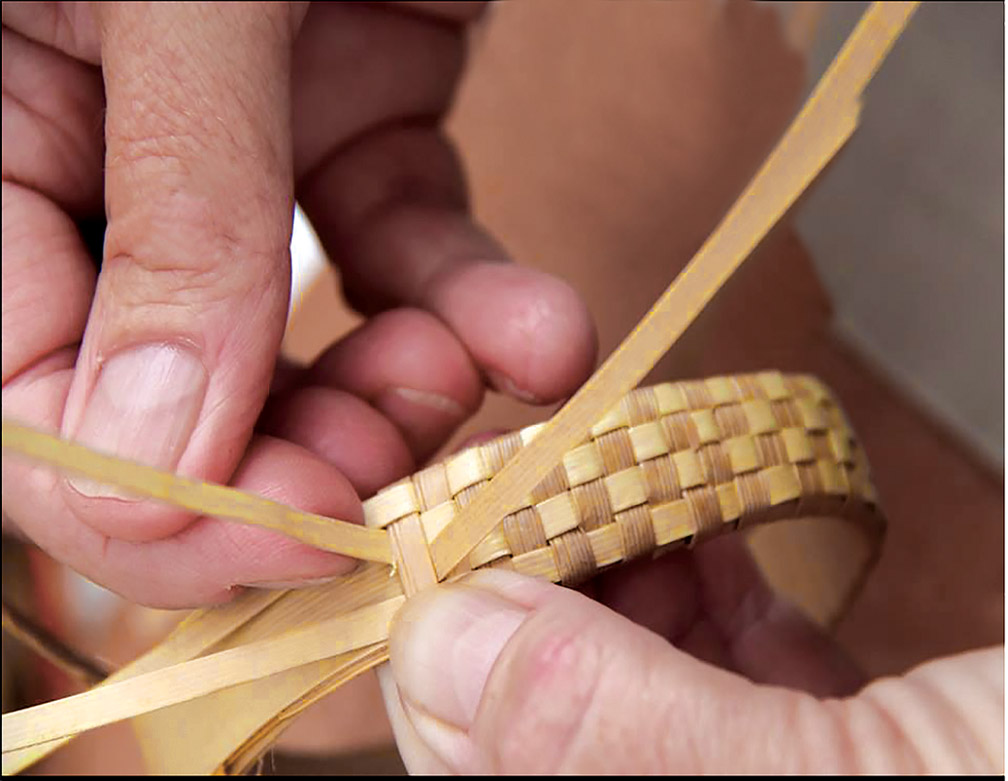
Hawai‘i Wedding Customs Come from Around the Globe
 Every day, wedding couples flock to Hawai‘i to exchange vows and wow their guests—or escape the pressure with a private elopement. Our beautiful romantic settings, near-perfect weather, and atmosphere that breathes aloha make these islands a destination of choice for wedding couples of all ages, backgrounds and cultures—each with their own expectations, customs, and traditions.
Every day, wedding couples flock to Hawai‘i to exchange vows and wow their guests—or escape the pressure with a private elopement. Our beautiful romantic settings, near-perfect weather, and atmosphere that breathes aloha make these islands a destination of choice for wedding couples of all ages, backgrounds and cultures—each with their own expectations, customs, and traditions.
The rich Hawaiian culture, filled with metaphor and imagery for the many expressions of love, wraps itself around weddings from Eastern, Western, and “fusion” cultures like a warm embrace. Here Jewish and Indian weddings are performed under canopies with ocean views; Hawaiian and Indian flower garlands adorn brides and grooms; Japanese and English words are interchanged in ceremonies; and brides from around the world experience their dream of the Western-style “white wedding.”
What’s different about wedding customs in Hawai‘i seems much less important than what’s shared. One remarkable example comes from Dr. Barry Blum of Shaloha Weddings in Kona.
“When we arrived in Kona, Seymour Lewis, the leader of the Jewish Congregation at the time, told us he had heard that 1,000 words were the same in Hawaiian and Hebrew,” says Barry.
“Hawai‘i, when pronounced in Hebrew, means, ‘Let us have an island.’ The name of the volcano goddess, Pele, means ‘naturally occurring miracle.’ ‘Strength’ in Hawaiian is koa, and in Hebrew, strength is koach (ko-ach). And, of course, both shalom and aloha mean hello, goodbye, and peace.”
Barry and his wife Gloria Blum responded to a need for Jewish wedding ceremonies in 2000, when there was no rabbi in Kailua-Kona. As president of Congregation Kona Beth Shalom, Barry began to study wedding practices and traditions.
“For Hawaiian tradition, I called on Leon Sterling, my friend and kahu (pastor), who probably married everybody in Hawai‘i in the past 100 years,” quipped Barry. “He was so gifted. I also asked friends who were rabbis and wedding officiants, to get ideas. The result is a wedding that is authentically Jewish and also includes Hawaiian poetry, prayer, and customs.”
“Many of the couples that choose us are interfaith.” says Gloria. “Rabbis are often reluctant to perform these ceremonies but we want to build bridges and share the universality of the Jewish wedding ceremony. “We’ve performed Jewish-Indian ceremonies, Jewish-Thai, Jewish-Japanese, Jewish-Filipino, Jewish-Hawaiian, Jewish-Christian, as well as other interfaith and of course, traditional Jewish ceremonies.”
“The world’s largest mikvah is the Pacific Ocean,” says Barry, referring to a ceremonial bath. “I suggest that the morning of, or the day before the wedding, they take themselves to the ocean, and while holding hands, ask each other for forgiveness for any way they may have offended each other, and immerse themselves in water together. Afterward, they immerse themselves individually, and ask to forgive themselves for any way they may have not lived up to their own expectations.”
Barry and Gloria’s shared love of their culture and music also inspired them to create “Kona’s Traveling Jewish Wedding Band” which continues to entertain wedding guests. “We will conduct the wedding, then run down the aisle and join the band and play for them,” says Gloria. “That good feeling of enjoying the spirit of weddings motivated us. Music was always and always will be a central, an integral part of the process.”
“Justice Anthony Kennedy says, ‘No union is more profound than marriage, for it embodies the highest ideals of love, fidelity, devotion, sacrifice, and family,’” says Barry. “In forming a marital union, two people become something greater than what they once were. It is not only a joy, it is an honor for us to perform a wedding.”
“By the time the wedding happens, they want you to be part of it,” says Jeannette Rhodes of Beach Weddings Hawai‘i, a boutique company, specializing in intimate weddings and elopements. “They’ll say, ‘come sit with us, have cake!’ It’s not just business; we really like making people happy,” she says.
Jeannette says elopements are growing in popularity, as more couples opt to save money for travel or home purchase, and to focus on their relationship. Their company commonly helps wedding parties of two to six people, who may choose a quietly elegant picnic on the beach instead of a fancy reception.
A professional hair and makeup artist, Jeannette is the creative director; husband Eric focuses on photography. Together, they offer with their “Muse Bride” service, a post-wedding, full-blown fashion shoot in the studio or on location at the beach, volcano, waterfalls, and elsewhere.
Their business partner, Reverend Dard Aller (a 28-year resident and six-time Ironman® finisher) handles the ceremony.
“His ceremony is so beautiful, so heartfelt,” says Jeannette. “He was a Christian minister for a long time, so he can do religious ceremonies or just those on the spiritual side. He does incorporate Hawaiian elements. He is really respectful of the culture and spiritual practices.”
For Japanese couples (a large part of their business), Dard may offer pule (blessings) in Hawaiian, and speak English for part of the proceedings, and when it is time to exchange vows, in a powerful shift, he switches to Japanese so the couple may fully participate in their own language.
Interestingly, for all its complex protocols in many other aspects of life, the early Hawaiian culture did not include a formal marriage ceremony, for most people. According to Mary Kawena Pukui in “Nānā I Ke Kumu,” the expression “noho pū ‘ana” (dwelling together without ceremony) or “no pū” (no ceremony) were used to describe a bonded couple. After a courtship period where the young man would prove himself a good provider, the families would get together to witness an exchange of promises, from the couple to each other, and to their parents. Lei maile, knotted and entwined to symbolize the union, would be present.
Polygamy was common, and it was expected that wives of one husband or husbands of one wife would be punalua, close friends and companions, in order to nurture a harmonious marriage all around. Following the elimination of the kapu system and arrival of Christian missionaries, polygamy was proclaimed illegal by Queen Ka‘ahumanu in 1835.
Unions of ali‘i (chiefs) required more elaborate preparations and protocols, as well as a generous dowry and discussions of land administration, a chiefly responsibility for two allying families. Kāhuna (priests) would consult the omens, and work to ensure that the bloodlines stayed pure and the couple’s mana (spiritual power) was untainted and properly aligned.
Kahu Wendell Silva, of Hawaii Cultural and Spiritual Services Center, uses the word “ho‘āo” for weddings. Ho‘āo literally translates “to stay or remain until daylight.” It also refers to the night of the day called Huna, eleventh night of the month, when the ho‘āo nuptials took place.
“What people most want today are authenticity and integrity,” Kahu says. He strives to incorporate Hawaiian language and ceremonial aspects into weddings, while allowing for Western nuptial traditions to also be represented.
“For a couple who is religious (Christian), I can read from First Corinthians,” says Kahu. “For us, aloha and the qualities it has for us are similar to what is written in the scripture. Love is universal. Aloha is universal, essential, it is the core of our belief system. And it was mandated by our ali‘i to share aloha with each other, and with all who come to our shores.”
For “Lei Aloha,” one of his most eloquent ceremonies, Kahu traditionally begins by chanting “Oli Ho‘okuakahi” to summon benevolent deities to bless the occasion and clear the path for the couple. This is followed by “Oli Aloha” to welcome everyone to the celebration and embrace them with aloha. Then, “Oli Lei,” dating back to the marriage preparations of Pele, is performed as the two adorn each other with lei—usually brought forth by their parents—to remind them of their love, the way that wedding rings are symbolic of love and commitment.
“We use flower garlands too,” says Mira Savara of Mira Savara Events, who performs Hindu, Vedic, and Sikh weddings on all the Islands. “We call them ‘Phulon ki mala,’ and we offer these to our gods during prayer. For weddings, the bride and groom exchange lei, and they have a special name, ‘jaimala.’”
Mira started doing Indian weddings when she and her family came to Hawai‘i in 1988. “I love my culture, the festivals, dancing, singing, and we didn’t have that in Hawai‘i,” says Mira. “I started incorporating all those things that I wanted the younger generation to learn.” Beginning with Indian dancing and Bollywood dance parties for friends, Mira was somewhat prepared when an Indian groom called from New York, whose Korean bride wanted a Western-style “white wedding,” in Hawai‘i, with some Indian cultural elements.
Mira is well-educated in Indian culture and customs, having gone through what she calls “cultural boot camp” at the home of her grandmother. Often elaborate, multi-day events, Mira’s weddings require a small army of vendors, entertainers and associates; and at present she will only book one wedding per month.
“We are so blessed we have the A-team of wedding professionals, who all learned the culture, and wanted to understand. I use an art school graduate as a henna artist, collaborated with a belly dancer to be a Bollywood dancer, worked with a design company on wedding canopies… We believe a lot in tradition and have to do it right.”
“Normally, the Indian wedding will start with a prayer,” says Mira. “On the second day, you might have henna art, cultural tradition, folk dancing. It is also a meet and greet, a welcome day for the families. And, third is the wedding ceremony, which is followed by the reception and dinner.”
The celebration will generally include a “Baraat,” the groom’s entourage. “This is like a ‘moment of glory’ for the groom,” says Mira. “He might ride a horse, or some kind of special wedding vehicle—helicopter, double-hulled canoe, surfboard, or even a Segway one time,” says Mira.
Obviously in love with her work and her culture, and like the Blum’s, Rhodes’, Silva’s and many others, Mira also has a strong sense of responsibility.
“Part of my mission is to mentor the younger generation to not forget their cultural tradition,” she says.
“I encourage them to use their wedding as an opportunity to enjoy, share and teach our culture.”
To all brides and grooms, Ho‘omaika‘i, Congratulations, Go kekkon omedetou gozaimasu, Mazel Tov! ❖
Contact Mira Savara
Contact Jeannette Rhodes
Contact Barry and Gloria Blum
Contact writer Catherine Tarleton


